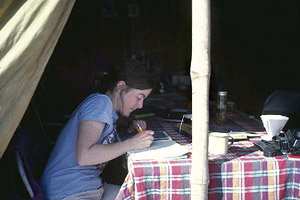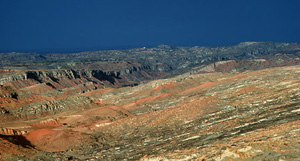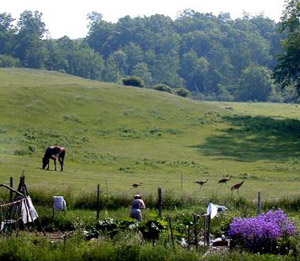

|
Dr. Catherine Badgley is a research scientist and assistant professor at the University of Michigan and President of the Society of Vertebrate Paleontology. Her research interests include the ecology and paleoecology of mammals, global trends in biodiversity, and current environmental issues. She is particularly interested in agriculture, because it has the greatest negative impact of any human activity on modern biodiversity. |
 Catherine Badgley adds to her notes during a field season in the Miocene of Pakistan. Photo by Kay Behrensmeyer. |
A: Paleontology is the study of the history of life in relation to Earth's environments. This history profoundly affects the natural world of today — in terms of the numbers and kinds of species present, where they live, their life habits, shapes, sizes, and behavior. The fossil record gives us fascinating examples of strange animals and plants of the past and also shows the underlying continuities from then to now, from them to us, through evolution and environmental history. The fossil record informs us of baselines for environmental change and documents the responses of organisms in terms of shifting geographic ranges, changes in local population size, evolutionary change, or extinction. These baselines help us understand the magnitude of human environmental impacts today. We also can evaluate our own impacts on the Earth and life, in comparison to earlier times with different organisms and physical processes. For all these reasons, paleontology is important and relevant in today's world.
Q: How did you end up becoming a paleontologist?
A: It started with my interest in nature as a child. I grew up in Colorado. We visited natural history museums and I came to love rocks, as well as living things. One of the exhibits I remember most was the giant clam (Tridacna) at the museum of the Colorado School of Mines, where my father was a professor of structural geology. During my freshman year in college, I found little in my introductory biology class about organisms and environments, but there was a lot about these subjects in my introductory geology class. I particularly liked the field work and the perspective geology gave me of the great depth of Earth's history. I majored in geology as an undergraduate, then went on to a Master's in wildlife ecology, and a Ph.D. in biology. For my dissertation, I worked on paleoecology, a synthesis of my background in geology and biology.
Q: Was there any person in particular who influenced your development as a scientist, in general, or as a paleontologist, in specific?
A: Steve Gould, my undergraduate advisor, was very supportive of women in science. He helped me to see myself as a person who had valid ideas to contribute. I didn't embrace all of his views or interests — he had a very eclectic mind — but he helped me focus on my subject and was a great role model. I appreciated both his scholarship and his friendship over three decades.
Q: Stephen Jay Gould, of course, a renowned paleontologist and evolutionary biologist. And your own training in paleoecology and evolution is extensive. How do you view the state of education about evolution in pre-college settings today?
A: Evolution is a fascinating subject: we have confidence in the theory, and there are still important research questions to solve. I look at some science texts and informal education settings, such as museums and science documentaries, and see lots of captivating information out there. That said, there is room for improvement. Often the texts and documentaries convey knowledge well about extinct creatures and remote time periods but have little to say about processes of evolution.
One of the things that puzzles me most is that the broader impacts of evolutionary theory are rejected by such a large percentage of the U.S. population. Why is evolution such a "threatening" subject compared to gravity or plate tectonics or quantum physics? I think that an important divide is whether people trust scientists or religious leaders as authorities about the ways of the world. Yet, there are many people of faith who accept evolution.
I find that lots of students at the University of Michigan have had little or no contact with evolution in high school. Yet many aspects of our food supply, modern medicine, and genetic profiling of offspring are examples of how evolutionary processes are relevant to daily life. It is unfortunate that so many people have no contact at all with the core principles of evolution — there are many intriguing concepts and fascinating evidence.
 A view of the Chinji Formation (Middle Miocene of the Potwar Plateau, Pakistan) following a storm. Photo by Catherine Badgley. |
Q: What are some of the research projects you have worked on?
A: My research interests are in paleoecology, taphonomy, and biogeography of mammals. My main field area is in Pakistan, where I have conducted field work as part of an international team since 1975. For many years, this team had a field season in Pakistan every year. The field area has a stack of riverine sediments over 4000 meters thick and covering almost 20 million years of time. Many of the fossils from those expeditions are on loan to our research group at Harvard, where other team members are based. I focus on evaluating changes in the mammals that inhabited the floodplains over millions of years. This long sequence documents some substantial changes in vegetation around the end of the Miocene (7.5 to 6.5 million years ago), and we are now working out how herbivorous mammals responded to these changes. For example, did they change their dietary habits as the vegetation changed from forest to grassland or retain their dietary habits and disappear? The answer is that quite a few species most reliant on forest plants became locally extinct, whereas a few species that had relied on shrubby leaves and grasses persisted and changed their diets to include more grass. We are evaluating this change in mammal species by documenting the diets of individual animals from microwear and isotopic analysis of teeth. This work allows us to study the ecological structure of fossil mammal assemblages.
Helping to develop field and analytical techniques to answer questions about mammalian ecosystems through time has been fascinating. Thirty years of work from my Ph.D. onward has led me to take a new look at modern ecosystems with questions about how modern mammals vary across the globe in relation to climate and vegetation. Perhaps the most engaging part of all this is the enlarged perspective on modern biology I now have, and how my reexamination of the modern world has expanded my perspective on Earth history.
Q: Pakistan is a pretty politically unstable area at this time. How was your experience working over there?
A: The international collaboration I work with is coordinated by people from Harvard University and the Geological Survey of Pakistan. Our field area is in the Punjab region of northern Pakistan. We haven't had a field season there since 9/11/2001, because U.S. activities in Afghanistan and Pakistan have made working there somewhat problematic. Before 2001, we had extremely positive interactions and experiences with colleagues in the Geological Survey and with villagers in our field area. I did return with a colleague to Islamabad for two weeks in January of 2007 to work on fossil material that we had collected earlier. We walked around Islamabad with friends and colleagues, but were not able to venture into the field. The people there live all the time with unpredictable violence, but they are working hard to make Pakistan a decent place to live. My friends there are still good friends, and I look forward to returning to Pakistan in the future.
Q: Doing research in Pakistan certainly sounds exciting. Is that the most exciting and/or interesting thing that has happened to you during your career in paleontology?
A: It has all been interesting — from finding fossils in the field to learning new ways to analyze data. Field experiences have been very satisfying, even when challenging. My research has taken me to parts of the world I would otherwise never have seen. Through fieldwork I have gained perspectives on the daily life of people very different from myself. Not that all of my experiences have been good or pleasant: you have to keep your eyes open to be able to address problems that confront you. I enjoy the intellectual aspects of field research and appreciate the intrinsic value of working on the record of Earth's history firsthand. Fieldwork has also given me a long view on modern environmental dilemmas that differs from that of people not steeped in the history of the Earth.
 Four sandhill cranes stroll by as Catherine putters in her farm's organic garden. Photo by Gerry Smith. |
Q: That brings to mind your recent research and publication on organic farming. How in the world did you get into agricultural research from paleontology?!
A: I became interested in agriculture from my research on biodiversity, especially the increasing number of endangered species and ecosystems. Modern agriculture affects almost half of the Earth's land area and poses many threats to local species richness as well as ecosystem functioning. Understanding how those impacts occur and evaluating more sustainable alternatives to modern industrial agriculture offers more positive options for the future.
Q: You obviously have a wonderful career and enjoy your work immensely. What advice would you give young people interested in becoming paleontologists?
A: Paleontology draws on many disciplines. Some of the most interesting paleontologists I know were English majors in college. But eventually, students interested in paleontology must become well grounded in the natural sciences. A strong background in geology and biology are essential. Within biology, evolution, ecology, and organismal biology are foundations for paleontology, but it's also important to know about biochemistry and developmental biology.
In addition, it is worthwhile to take a minimum of two years of math and statistics courses in college, because more and more paleontology is becoming quantitative. Reading what paleontologists are writing in both technical articles and popular literature provides insight on what paleontologists do and where the science is going. Scientists need to communicate well, so it's important to develop good writing skills.
Over my lifetime, the number of jobs for paleontologists has decreased, even though many students are enrolled in graduate programs in paleontology all over the world. The declining academic interest in organismal biology in favor of genetics and molecular biology has contributed to the loss of jobs in paleontology. Vertebrate paleontology has been particularly affected. It's a disturbing trend in light of the current environmental crises and the impacts of human societies on the natural world. The aspiring paleontologist must demonstrate the relevance of his or her subject area to a broad range of geologists and biologists alike. The integration of paleontology with evolution, phylogeny reconstruction, ecology, geochemistry, developmental biology, and global change, as well as the continuing discoveries from the fossil record suggest that we have a long past in front of us!
|
site tour |
about the site |
site map |
site credits |
help |
FAQs |
contact |
||